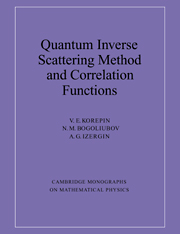Book contents
- Frontmatter
- Contents
- Preface
- Part I The Coordinate Bethe Ansatz
- Part II The Quantum Inverse Scattering Method
- Part III The Determinant Representation for Quantum Correlation Functions
- Part IV Differential Equations for Quantum Correlation Functions
- Introduction to Part IV
- XIII Correlation Functions for Impenetrable Bosons. The Determinant Representation
- XIV Differential Equations for Correlation Functions
- XV The Matrix Riemann-Hilbert Problem for Correlation Functions
- XVI Asymptotics of Temperature-dependent Correlation Functions for the Impenetrable Bose Gas
- XVII The Algebraic Bethe Ansatz and Asymptotics of Correlation Functions
- XVIII Asymptotics of Correlation Functions and the Conformal Approach
- Final Conclusion
- References
- Index
XIV - Differential Equations for Correlation Functions
Published online by Cambridge University Press: 04 August 2010
- Frontmatter
- Contents
- Preface
- Part I The Coordinate Bethe Ansatz
- Part II The Quantum Inverse Scattering Method
- Part III The Determinant Representation for Quantum Correlation Functions
- Part IV Differential Equations for Quantum Correlation Functions
- Introduction to Part IV
- XIII Correlation Functions for Impenetrable Bosons. The Determinant Representation
- XIV Differential Equations for Correlation Functions
- XV The Matrix Riemann-Hilbert Problem for Correlation Functions
- XVI Asymptotics of Temperature-dependent Correlation Functions for the Impenetrable Bose Gas
- XVII The Algebraic Bethe Ansatz and Asymptotics of Correlation Functions
- XVIII Asymptotics of Correlation Functions and the Conformal Approach
- Final Conclusion
- References
- Index
Summary
Introduction
The natural language for the description of correlation functions in exactly solvable models is the language of differential equations. The determinant representation of correlation functions in the previous chapter can be used to obtain these differential equations. An ordinary differential equation (of the Painlevètype) for the equal-time, zero temperature correlation function of the impenetrable Bose gas was obtained in. In that paper (starting from Lenard's formula for the two-point zero temperature equal-time correlator of impenetrable bosons) it was shown that the correlator is described by an ordinary differential equation (reducible to the Painlevè trascendent), and multipoint zero temperature equal-time correlators were also described as solutions of differential equations. The considerations in that paper were based on the spectral isomonodromic deformation method.
Our approach here is different. We begin by considering the logarithm of the determinant of the linear integral operator entering the representation for the correlator as a τ-function for some integrable nonlinear evolutionary system. Then the linear integral equations playing the role of the Gel'fand-Levitan-Marchenko equations for this integrable system are constructed. The differential equations for correlators are derived, in fact, from these integral equations (it is worth mentioning that the idea of obtaining the differential equations from the integral ones can be found in. This approach permits one to include time- and temperature-dependent correlators for impenetrable bosons in the same framework. It is remarkable that space- and time-dependent correlation functions are derived by partial differential equations which almost coincide with the original classical nonlinear Schrödinger equation, the only difference being that complex involution is dropped.
- Type
- Chapter
- Information
- Quantum Inverse Scattering Method and Correlation Functions , pp. 315 - 376Publisher: Cambridge University PressPrint publication year: 1993



